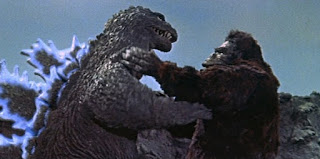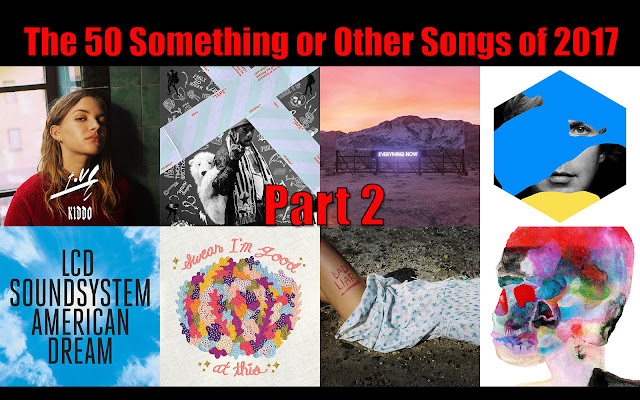 Let's get this straight right from the beginning: Even in a flat-out test of pure strength, Godzilla is going to nail King Kong to the wall. Godzilla, even in his clownish hero persona of the late '60s-early '70s, is still going to clean the clock with the mighty Kong. Godzilla, even at the lowest estimates of his height (say around 200') is still several times bigger than the true Kong, who ranges from 25 to 50 feet, depending on the scene in which he appears.
Let's get this straight right from the beginning: Even in a flat-out test of pure strength, Godzilla is going to nail King Kong to the wall. Godzilla, even in his clownish hero persona of the late '60s-early '70s, is still going to clean the clock with the mighty Kong. Godzilla, even at the lowest estimates of his height (say around 200') is still several times bigger than the true Kong, who ranges from 25 to 50 feet, depending on the scene in which he appears.
Remember, Godzilla is sung about in the theme song to the '70s Hanna-Barbera cartoon series as being "40 stories high". Using ten feet as an average for a story in a building, that's 400 feet tall right there, people. Even at half that size, Godzilla can easily step on Kong and then scrape him off his foot onto Mt. Fuji, if he chose, and I haven't even begun to factor in his radioactive breath, which is far more effective in his current incarnation. [Editor's note: "current incarnation" referred to his status as of 2005. The most recent Godzilla film was Godzilla: Final Wars, where the Big G full-on blasts the American 'Zilla from 1998 into the Sydney Opera House in about 30 seconds of screen time. In that film, Godzilla kicked major ass.]
 But, the Kong that Toho rented from RKO in the '60s was a different breed of cat... er, ape. He suddenly equaled Big G in height and strength, and mostly shrugged off the fiery blasts from the Japanese King of the Monsters. (Kong's arm catches on fire briefly at one point, which seems to bother him, but then he picks up the fight again.) I was shocked by this behavior when I saw the film not long after first watching the original Kong fall off the Empire State Building. In my head, Kong was dead, and then suddenly there was this ill-suited, scruffy imposter calling himself King Kong and fighting a giant octopod on a South Seas island, and eventually careening in and out of battles with the Big Green Guy around Tokyo. Even then, I noticed the decided lack of quality in the Toho version when measured against the RKO classic, and was especially disappointed in the use of the standard man-in-a-suit for Kong, rather than the far more impressive use of stop-motion animation. (I was already used to Godzilla being a guy in a suit; it was, and is, part of the charm of the character.)
But, the Kong that Toho rented from RKO in the '60s was a different breed of cat... er, ape. He suddenly equaled Big G in height and strength, and mostly shrugged off the fiery blasts from the Japanese King of the Monsters. (Kong's arm catches on fire briefly at one point, which seems to bother him, but then he picks up the fight again.) I was shocked by this behavior when I saw the film not long after first watching the original Kong fall off the Empire State Building. In my head, Kong was dead, and then suddenly there was this ill-suited, scruffy imposter calling himself King Kong and fighting a giant octopod on a South Seas island, and eventually careening in and out of battles with the Big Green Guy around Tokyo. Even then, I noticed the decided lack of quality in the Toho version when measured against the RKO classic, and was especially disappointed in the use of the standard man-in-a-suit for Kong, rather than the far more impressive use of stop-motion animation. (I was already used to Godzilla being a guy in a suit; it was, and is, part of the charm of the character.)
 But, the Kong that Toho rented from RKO in the '60s was a different breed of cat... er, ape. He suddenly equaled Big G in height and strength, and mostly shrugged off the fiery blasts from the Japanese King of the Monsters. (Kong's arm catches on fire briefly at one point, which seems to bother him, but then he picks up the fight again.) I was shocked by this behavior when I saw the film not long after first watching the original Kong fall off the Empire State Building. In my head, Kong was dead, and then suddenly there was this ill-suited, scruffy imposter calling himself King Kong and fighting a giant octopod on a South Seas island, and eventually careening in and out of battles with the Big Green Guy around Tokyo. Even then, I noticed the decided lack of quality in the Toho version when measured against the RKO classic, and was especially disappointed in the use of the standard man-in-a-suit for Kong, rather than the far more impressive use of stop-motion animation. (I was already used to Godzilla being a guy in a suit; it was, and is, part of the charm of the character.)
But, the Kong that Toho rented from RKO in the '60s was a different breed of cat... er, ape. He suddenly equaled Big G in height and strength, and mostly shrugged off the fiery blasts from the Japanese King of the Monsters. (Kong's arm catches on fire briefly at one point, which seems to bother him, but then he picks up the fight again.) I was shocked by this behavior when I saw the film not long after first watching the original Kong fall off the Empire State Building. In my head, Kong was dead, and then suddenly there was this ill-suited, scruffy imposter calling himself King Kong and fighting a giant octopod on a South Seas island, and eventually careening in and out of battles with the Big Green Guy around Tokyo. Even then, I noticed the decided lack of quality in the Toho version when measured against the RKO classic, and was especially disappointed in the use of the standard man-in-a-suit for Kong, rather than the far more impressive use of stop-motion animation. (I was already used to Godzilla being a guy in a suit; it was, and is, part of the charm of the character.) No, this was not my Kong. This one was the same size as Godzilla! I already knew Godzilla to be of unimaginable proportions (around 150 feet tall in the '60s films), and suddenly the big ape that still had to climb laboriously up the Empire State Building was now going to be over a tenth of the size of it? To be sure, there is a plotline about some berries on Kong's island (that is never called Skull Island, so perhaps he is a further-removed offshoot of the species?) that allow the creatures to devour them to grow to monstrous sizes. Maybe this Kong was once normal Kong-sized and ate enough berries to be Godzilla-sized? (The berries also conveniently cause Kong to fall asleep, thus providing a plot device with which to transport the beast.) It also causes Kong to look constantly like he just woke up from a three-night bender.
No, this was not my Kong. This one was the same size as Godzilla! I already knew Godzilla to be of unimaginable proportions (around 150 feet tall in the '60s films), and suddenly the big ape that still had to climb laboriously up the Empire State Building was now going to be over a tenth of the size of it? To be sure, there is a plotline about some berries on Kong's island (that is never called Skull Island, so perhaps he is a further-removed offshoot of the species?) that allow the creatures to devour them to grow to monstrous sizes. Maybe this Kong was once normal Kong-sized and ate enough berries to be Godzilla-sized? (The berries also conveniently cause Kong to fall asleep, thus providing a plot device with which to transport the beast.) It also causes Kong to look constantly like he just woke up from a three-night bender. |
| Who designed me? Idiots... |
 |
| I had two copies of KKvG on VHS, including this version. |
It doesn't matter. In the Japanese release of King Kong vs. Godzilla, we not only hear King Kong roar in supposed triumph as he swims away toward the horizon, but we also hear Godzilla's roar one more time. As for me, I'm taking no political sides in the King Kong vs. Godzilla debate, except to say that the Kong in the movie is not the Kong that I love and that Godzilla in the film is the Godzilla that I love. I absolutely declare the ending a draw. The Myth of Two Endings is just that: a myth. There were never two endings; just one big ambiguous earthquake-and-tidal-wave-causing fall into the ocean by two monstrous titans of pop culture. And whoever said you can't love them both? Not me, clearly.
Long Live the Kings...
[To be continued in Part 8...]




No comments:
Post a Comment